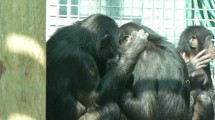Abstract
The pygmy chimpanzee, or bonobo, Pan paniscus,diplays a fission-fusion social organization in which individuals associate in parties that vary in size and composition. Data from a 2-year field study of nonprovisioned P. paniscusshow that party composition varies with party size. Although females, on average, outnumber males, the proportion of males in the party increases in larger parties. This effect was not due to the greater number of known females. Both females and males will join and leave a party in the company of others, but only males appear frequently to join or leave as lone individuals. All-male parties were not observed, but all-female (nonnursery) parties were relatively common. These trends reflect greater cohesion among females than observed in P. troglodytes schweinfurthii.Cohesion between males and female P. paniscusmay increase with party size.
Similar content being viewed by others
References
Badrian, A. J., and Badrian, N. L. (1984). Group composition and social structure ofPan paniscus in the Lomako Forest. In Susman, R. L. (ed.),The Pygmy Chimpanzee;Evolutionary Biology and Behavior, Plenum Press, New York, pp. 325–346.
Goodall, J. (1983). Population dynamics during a 15-year period in one community of free-living chimpanzees in the Gombe National Park, Tanzania.Z. Tierpsychol. 61: 1–60.
Goodall, J. (1986).The Chimpanzees of Gombe: Patterns of Behavior, Harvard University Press, Cambridge, Mass.
Halperin, S. D. (1979). Temporary association patterns in free ranging chimpanzees: An assessment of individual grouping preferences. In Hamburg, D. A., and McCown, E. (eds.),The Great Apes, Benjamin Cummings, Palo Alto, Calif., pp. 491–499.
Kano, T. (1982). The social group of pygmy chimpanzeesPan paniscus of Wamba.Primates 23: 171–188.
Kitamura, K. (1983). Pygmy chimpanzee association patterns in ranging.Primates 24: 1–12.
Kuroda, S. (1979). The social group of the pygmy chimpanzee.Primates 20: 161–183.
Nishida, T. (1968). The social group of wild chimpanzees in the Mahali Mountains.Primates 9: 167–224.
Nishida, T. (1979). The social structure of chimpanzees of the Mahale Mountains. In Hamburg, D. A., and McCown, E. (eds.),The Great Apes, Benjamin Cummings, Palo Alto, Calif., pp. 72–121.
Nishida, T., and Hiraiwa-Hasegawa, M. (1987). Chimpanzees and bonobos: Cooperative relationships among males. In Smuts, B. B., Cheney, D. L., Seyfarth, R. M., Wrangham, R. W., and Struhsaker, T. T. (eds.),Primate Societies, University of Chicago Press, Chicago, pp. 165–180.
Sokal, R. R., and Rohlf, F. J. (1981).Biometry, 2nd ed., Freeman, New York.
Thompson-Handler, N., Malenky, R. K., and Badrian, N. (1984). Sexual behavior ofPanpaniscus under natural conditions in the Lomako Forest. In Susman, R. L. (ed.),The Pygmy Chimpanzee;Evolutionary Biology and Behavior, Plenum Press, New York, pp. 347–368.
Thompson-Handler, N., Malenky, R. K., White, F. J., and Lanjouw, A. (1986). Reproductive and affiliative behavior and the social organization of pygmy chimpanzees. Paper presented at Understanding Chimpanzees Symposium, Chicago Academy of Sciences, Chicago.
White, F. J. (1986).Behavioral Ecology of the Pygmy Chimpanzee, Ph.D. thesis, State University of New York at Stony Brook.
White, F. J., and Burgman, M. A. (1987). Associations between individual pygmy chimpanzees; numerical taxonomic analysis of party composition.Am. J. Phys. Anthropol. 72: 268–269.
Wrangham, R. W. (1975).The Behavioural Ecology of Chimpanzees in Gombe National Park, PhD. thesis, University of Cambridge, Cambridge.
Wrangham, R. W. (1979a). On the evolution of ape social systems.Soc. Sci. Inform. 18:335–368.
Wrangham, R. W. (1979b). Sex differences in chimpanzee dispersion. In Hamburg, D. A., and McCown, E. (eds.),The Great Apes, Benjamin Cummings, Palo Alto, Calif., pp. 481–489.
Wrangham, R. W. (1980). An ecological model of female-bonded primates.Behaviour 75: 262–300.
Author information
Authors and Affiliations
Rights and permissions
About this article
Cite this article
White, F.J. Party composition and dynamics inPan paniscus . Int J Primatol 9, 179–193 (1988). https://doi.org/10.1007/BF02737400
Received:
Revised:
Issue Date:
DOI: https://doi.org/10.1007/BF02737400




